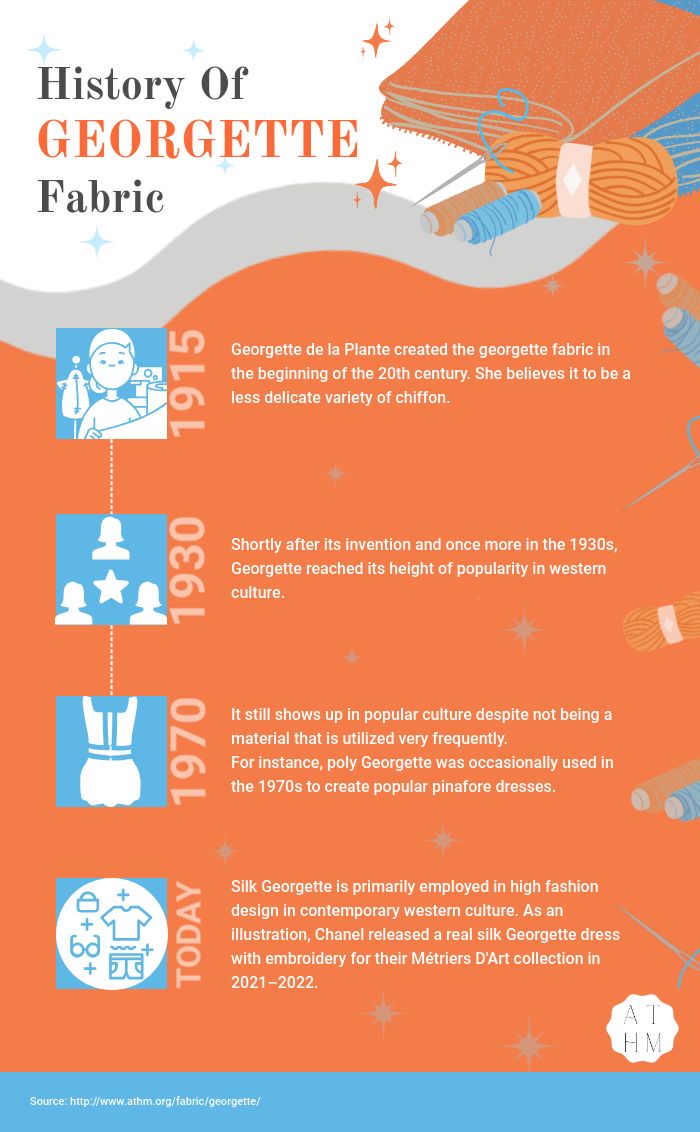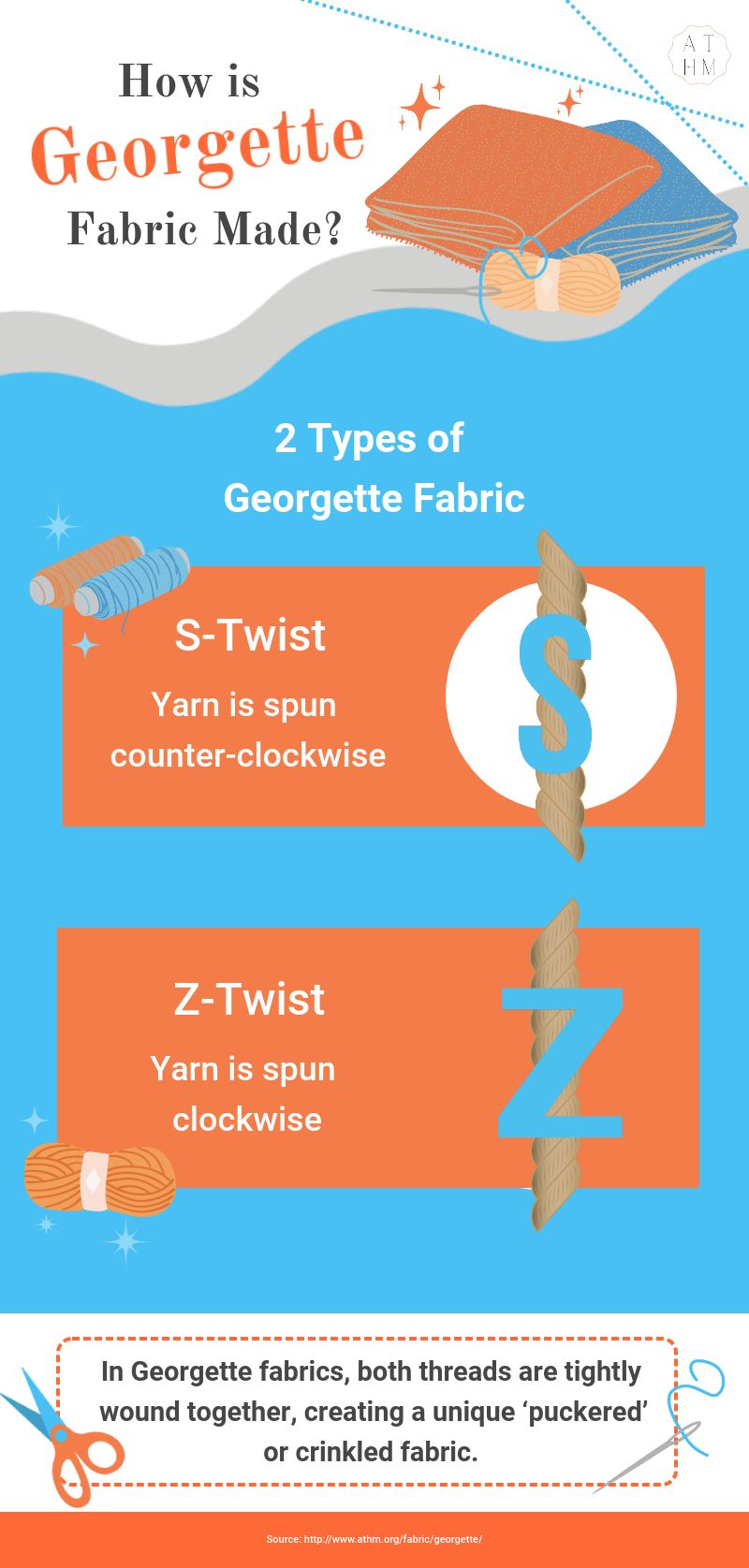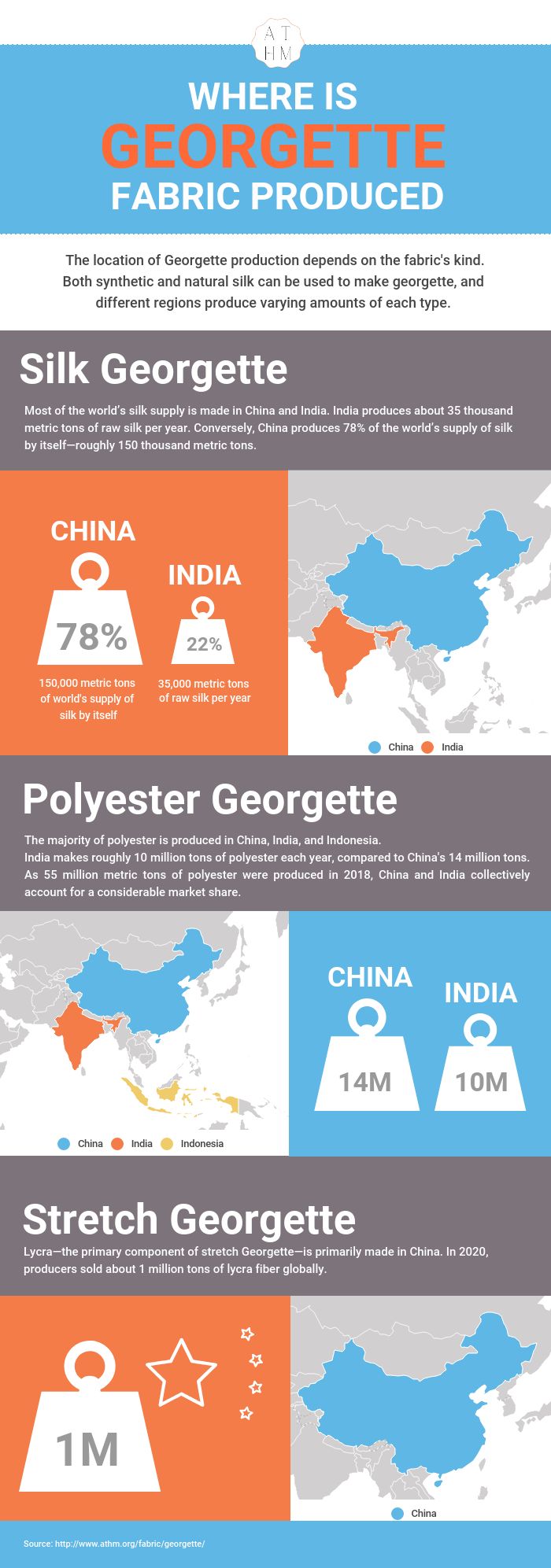Georgette fabric is a sister fabric of crêpe fabric that is sheer, light, and flowy. It is usually made from silk but can also be made with other synthetic materials.
French designer Georgette de la Plante invented the Georgette fabric in the early 20th century. Plante was likely inspired by chiffon, which is similar in texture and popular at the time but was easily breakable and difficult to use.
Georgette is a unique fabric that is lightweight, sheer, and breathable. It has a signature crinkle that sets it apart from other silky fabrics. It is known for flattering and draping beautifully when worn in a dress.
Georgette fabric is more robust than chiffon fabric but is challenging to maintain. It does not do well getting wet, especially if the water is warm. It cannot be tumble dried and should, in most cases, be dry cleaned.
Historically, textile makers made Georgette from natural silk, but innovations have allowed Georgette to be made from all kinds of materials. Today, most mass-produced Georgette is made in India, Italy, and Switzerland and is used by fashion designers worldwide.
What Is Georgette Fabric?
Georgette Fabric is in the crêpe family of fabrics. Crêpe fabrics are delicate fabrics woven from silk, and Georgette is no exception. Georgette fabric was initially woven from silk, but it is now often made from less expensive synthetic materials.
Georgette can be identified by its rough, crumpled texture made from tightly woven s-twist and z-twist threads. The threads are twisted in opposite directions, which creates a crinkled texture that sets it apart from other silky fabrics.
History of Georgette Fabric

Georgette fabric was invented in the early 20th century by Georgette de la Plante. She likely created the fabric to be a less fragile form of chiffon. Over time, Georgette fabric has evolved, and it is now often made from less expensive synthetic materials.
Georgette peaked in popularity in western culture for a short period after its creation and then again in the 1930s. Despite not being a very commonly used fabric, it still appears in popular culture. For example, staple pinafore dresses in the ’70s were sometimes made with polyester Georgette.
In modern western culture, silk Georgette is mostly used in high fashion circles. For example, Chanel put out an embroidered real silk Georgette dress for their 2021/22 Métriers D’Art collection.
While Georgette fabrics may have fallen in popularity in the west, they have grown in popularity in Eastern countries like India. Saris are a perfect place to use Georgette fabric, and elaborate, draped, patterned silk Georgette saris have exploded in popularity for those with the money to buy them.
Properties and Characteristics of Georgette Fabric
Georgette fabrics use S- and Z-twisted yarns tightly woven together, creating a unique crinkled fabric. This particular weave allows Georgette to be made of silk and fine thread while maintaining its more robust structure than other silk fabrics.
Georgette is light and airy. It can be opaque or translucent, though it always has a sleek, flat, matte sheen. Like most silk fabrics, Georgette is not prone to pilling.
The properties of non-silk Georgette fabrics largely depend on the material from which they are made. For example, polyester Georgette will absorb less moisture than natural silk Georgette.
Properties of Silk Georgette Fabric:
- Lightweight
- Fairly breathable
- High moisture-wicking ability
- Medium stretchiness
- Low pilling
- Medium breathability
- Sheer
Types of Georgette Fabric
Georgette is a way of creating fabric from yarn, and designers have found ways to craft Georgette with all kinds of materials. Designers also use different versions of the original Georgette weave for various purposes, creating different Georgette fabric types.
Georgette Fabrics of Different Materials
Textile makers can create Georgette fabric out of different materials. These other materials give the Georgette different properties that make them useful for different things.
Silk Georgette
Silk Georgette is the original Georgette fabric. When someone refers to ‘Georgette fabric’ without specifying which one they mean, they are likely referring to silk Georgette.
Polyester Georgette
Polyester Georgette is also known as poly Georgette. It is a high-class, light, flowy fabric that is less expensive than silk Georgette. The polyester in this fabric allows it to be washed in a machine and be wrinkle-resistant. Poly Georgette even appeared in the Hermès Autumn and Winter 21/22 collection.
Stretch Georgette
Stretch Georgette is made from spandex or Lycra. Adding these synthetic materials allows the Georgette to be more stretchy and comfortable. Stretch Georgette is often used in bridal wear to create a smooth, flowy appearance that is less stiff and expensive than pure silk.
Different Georgette Weaving Techniques
There are variations in Georgette fabric making that give each fabric unique properties.
Double Georgette
Regular Georgette fabric is light and often sheer. Double Georgette fabrics are thicker, which offers more coverage and durability for the wearer.
Satin Georgette
Satin Georgette fabric can be made from synthetic material or silk. The satin weave of the fabric makes it shiny, the opposite of standard Georgette, which is matte.
Jacquard Georgette
Georgette fabric can be woven on a jacquard loom to create a jacquard weave. Jacquard looms allow fabrics to have woven patterns rather than patterns dyed or stitched on top.
How Is Georgette Fabric Made?

Two yarns are used to make Georgette fabrics: S-twist and Z-twist. S-twist yarn is spun counter-clockwise, and Z-twist yarn is spun clockwise. In Georgette fabrics, both threads are tightly wound together, creating a unique ‘puckered’ or crinkled fabric.
How Is Georgette Fabric Used?
Georgette fabric is mostly used in clothing, but it is occasionally used in home design as well. As it is not exceptionally durable, Georgette fabric doesn’t have many uses outside decoration and apparel.
Georgette Dresses
Georgette fabrics of any type are perfect for dresses. The material is often used in ballgowns and bridal wear, as well as other clothes for formal occasions. Georgette works exceptionally well with empire waists, a-line, ball gowns, and wrap dresses, but any flowy dress form will work perfectly as a Georgette dress.
Georgette dresses are not exclusively luxury items, either. While it is used by many runway makers and in many formal-wear dresses, designers also use Georgette in casual wear. Short summer dresses are often made of Georgette fabric because of its cool breathability.
Georgette Blouses
Loose-fitting blouses are the perfect venue for Georgette fabrics. Three-quarter, long, and short sleeves all look beautiful with Georgette fabrics of any type.
Georgette Saris
Many people prefer Saris made from Georgette fabrics, especially silk Georgette fabrics. Saris are layered and come in bright patterns with deep and vibrant colors, ideally suited to Georgette’s light and airy texture.
Georgette Home Decoration
Georgette fabrics are primarily used in apparel but have also found their way into homes. While Georgette is not sturdy enough to be a rug or cushion cover, it is often used for window covers, pillows, and table decorations.
Advantages of Georgette Fabric
Silk Georgette is light, flowy, and comfortable. It hugs curves while still being loose enough to look good on any body type. Pure silk Georgette is breathable and perfect for Spring and Summer.
Silk fabrics are highly absorbent, which will keep the wearer cool and has the added benefit of taking dyes well. Silk Georgette makes bright, vibrant colors that stand out in a crowd.
One of the most significant benefits of silk is that it is clean. Silk repels mold and dust, which makes it both easy to store and hypoallergenic.
Silk Georgette is not a strong fabric but is still stronger than chiffon. This extra strength means that designers can embroider it and treat it slightly less delicately than other materials.
Disadvantages of Georgette Fabric
Silk Georgette is beautiful, drapes nicely, and flows like water, but it can be tricky to maintain. You cannot dry Georgette silk in the sun as it may lose some of its color. It is expensive and difficult for even expert sewists to use.
Alternatives to Georgette Fabric
Some consumers may want to avoid Silk Georgette as silk can be challenging to maintain. The best silk Georgette alternatives are Georgette fabrics made from more manageable materials. Stretch Georgette and poly Georgette are the best alternatives to silk Georgette.
Georgette fabric is tough to work with due to its sheer, delicate nature, so many casual sewists look for simpler alternatives to Georgette that maintain the slinky, flowy feel that Georgette achieves.
The best alternatives for sewers that want the same feel as Georgette but don’t have the sewing skills required for the tricky fabric are silk charmeuse, light jersey cotton, or Lycra.
For sewists that want the same look as Georgette but need less translucent fabric that covers more (for a dress or blouse, for example), silk crepe de chine is a perfect alternative.
Silk Charmeuse vs. Georgette
Silk Charmeuse uses a technique with more threads going over than under in the weave. This weave gives the fabric a shinier finish on the front side and a matte finish on the backside. While any silk is tricky to sew, Charmeuse is slightly more manageable due to its flat back.
Silk Charmeuse will provide the same water-like quality as Georgette but will be slightly easier to sew.
Jersey Cotton vs. Georgette
Jersey cotton without synthetic fibers has much of the same drapey, flowy feel as Georgette but is much easier to sew. It is also less expensive than Georgette fabric and more forgiving.
Jersey cotton uses interconnected rows to create a stretchy, flowy fabric. Jersey cotton is not a woven fabric like Georgette and Charmeuse. It is instead knit, which makes it much easier to sew. Sewists will find that Jersey cotton is not much more challenging to work with than regular cotton.
Lycra Blends vs. Georgette
Lycra is a synthetic fabric often added to other fabrics to make them stretchier. Most Lycra blends are slinky like silks but flexible and easier to sew. Manufacturers often mix Lycra with materials like polyester, cotton, and wool to create stretchy blends.
Silk Crepe de Chine vs. Georgette
Silk crepe de chine is wrinkle-resistant, breathable, and durable. It is much thicker than Georgette, offering the wearer extra coverage. It is, however, silk, which means that it is not any easier to sew than Georgette.
Where Is Georgette Fabric Produced?
Where Georgette fabric is produced depends on the type of Georgette fabric. Georgette can be made of synthetic materials and natural silk, and different places make different amounts of each kind of Georgette.

Silk Georgette Production
Most of the world’s silk supply is made in China and India. India produces about 35 thousand metric tons of raw silk per year. Conversely, China produces 78% of the world’s supply of silk by itself- roughly 150 thousand metric tons.
Polyester Georgette Production
Most polyester manufacturers are in China, India, and Indonesia. China produces about 14 million tons of polyester yearly, while India makes about 10 million tons. Together, China and India make up a significant market share, as 55 million metric tons of polyester were produced in 2018.
Stretch Georgette Production
Lycra- the primary component of stretch Georgette- is primarily made in China. In 2020, producers sold about 1 million tons of lycra fiber globally.
How Much Does Georgette Fabric Cost?
Georgette fabric costs vary widely depending on the material they’re made from and any additional features they may have. Embroidered or embellished Georgette weave fabrics cost more, and synthetic Georgette fabrics cost less.
How Much Does Silk Georgette Cost?
Solid-colored silk Georgette usually costs about $20-$40 per yard. Patterned silk Georgette fabrics cost more, usually around $30-$60 per yard. Embellished Silk Georgette fabrics, such as embroidered or sequined fabrics, can cost anywhere from $40 per yard to $140 per yard.
How Much Does Poly Georgette Cost?
Polyester Georgette tends to cost less than silk Georgette. However, like silk Georgette, patterned synthetics tend to cost more. Patterned synthetic Georgette is usually $7-$15 per yard, while solid fabrics made of synthetic Georgette usually costs $5-$7 per yard.
Embellished fabrics can cost much more, especially if they are handmade, but most embellished retail polyester Georgette costs about $13-$30 per yard.
What Certifications Are Available for Georgette Fabric?
Various certifications are available to ensure that silk is real, ethically sourced, and safe. Each certification check ensures different regulations are met so that consumers know their products are the best they can be.
OEKO-TEX® Certification for Silk
OEKO-TEX® is a certification system that ensures textiles are free from potentially harmful chemicals. OEKO-TEX® independently tests materials for things like arsenic, lead, pesticides, formaldehyde, and more.
These chemicals can be dangerous, especially if they come in close contact with your skin, as clothes do. Brands that sell silks that are OEKO-TEX® certified are guaranteed to be free of these chemicals.
OEKO-TEX® offers additional certifications as well for standards aside from safe chemicals. For example, OEKO-TEX® Made in Green certifies that clothes meet the regular safety standards, as well as safe working conditions and environmental standards.
Silks can also meet the OEKO-TEX® Standard 100, which ensures that products are free from harmful substances at all stages of production, not just as the final step. This standard is essential if the silk Georgette is going to be used for tablecloths or placemats that will be close to your food, as it eliminates the risk of trace chemicals in the places that matter most.
GOTS Certification for Silk
The Global Textile Standard (GOTS) certification verifies for consumers that a textile has been sustainably sourced from start to finish. It is the highest possible award for organic fabrics available.
GOTS-certified silks must have at least 70% organic material to claim they are made with organic material and must have a minimum of 90% organic material for manufacturers to label them as organic.
All GOTS-certified silks must maintain socially responsible labor practices, including no child labor and unsafe working conditions. All workplaces must also allow their workforces to bargain collectively.
Ensuring That Silk Is Real
In most countries, items marked as silk must be made of natural silk and contain no synthetic materials. However, if you are buying silk Georgette in other countries or second-hand, you may want to ensure that the silk is natural. There are a few ways of ensuring that that silk is real.
Hand Touch Test
One of the easiest ways to make sure that silk is real is to feel it. Real silk should feel soft and waxy. Silk Georgette may be slightly rougher than other silk, but it should still be much smoother than alternative Georgette fabrics.
The Ring Test
To authenticate silk, pull a piece of fabric through a jewelry ring. If the silk is real, it should pull through easily without snagging. Thicker silks may be more difficult to pull through, but silk Georgette should glide easily.
The Burn Test
The burn test is the best way to be sure that your material is real silk. But, unfortunately, it is also the most dangerous and likely to get you kicked out of a store.
If you already have the ‘silk’ item you want to test, burn a small part of the fabric. Because silk is a natural fiber, it should smell similar to burnt hair and leave ash behind. Synthetic silks will leave no ash and smell like burning plastic or rubber.
The Silk Mark
India is one of the world’s leading producers of silk. To better protect consumers, the Indian government has endorsed the usage of the silk mark. Manufacturers can be certified by a board that will allow them to use the silk mark label.
It should be noted that the silk mark is not a legal mark and does not necessarily ensure that fabrics are 100% real silk. Some makers have also been known to fake the silk mark. The best way to ensure that you have real silk is to test it yourself or purchase silk with other authentications.
What Is the Environmental Impact of Georgette Fabric?
The environmental impacts of Georgette fabric depend on what type of Georgette fabric it is. Pure silk Georgette fabrics will have very different ecological impacts than poly Georgette or stretch Georgette fabrics.
What Is the Environmental Impact of Silk Georgette Fabric?
Silk is a natural fiber, so it doesn’t shed microplastics like some synthetic alternatives. There are other environmental concerns regarding silk, however.
Silk is made from moth larvae cocoons. The moth cocoons contain what are usually called silkworms. These silkworms and moths used to make silk are usually harvested from mulberry trees.
It is difficult to say how many hectares of land and mulberry trees it takes to create one yard of silk. The Counsel of Fashion Designers of America (CFDA) states that it takes one hectare of mulberry trees to make 40kg of raw silk.
Fibershed, on the other hand, says that one hectare of mulberry trees can make 111kg of raw silk. Fibershed is a nonprofit organization that works to develop local textile systems that are good for developing countries and the environment.
Regardless of land and water usage, creating silk requires moths and silkworms. Many activists have raised concerns regarding the welfare of moths. Most silkworms die in the harvesting of their cocoons before they reach adulthood, which many people believe is cruel and unnecessary.
Peace silk has been developed to mitigate some of the impacts on moths. Peace silk, also called Ahimsa silk, is produced without harming silkworms.
There are many kinds of available peace silk, including Tussar silk, Mulberry silk, Eri silk, Muga silk, and Noil silk. Silk Georgette can be made from all of these types of silk.
What Is the Environmental Impact of Synthetic Georgette Fabric?
Polyester fabric, which Poly Georgette is made from, is universally considered harmful to the environment. Polyester fabric is made using fossil fuels, which are not renewable and release carbon dioxide into the atmosphere.
Polyester is also not biodegradable and remains in the biosphere for thousands of years. Even if it is not thrown out, polyester releases microplastics every time it is washed. The microplastics released from synthetic textiles end up in drinking water, food, and even the human body.
Lycra, more commonly known as spandex, from stretch Georgette can also shed dangerous microplastics into the water and the ground when washed.
